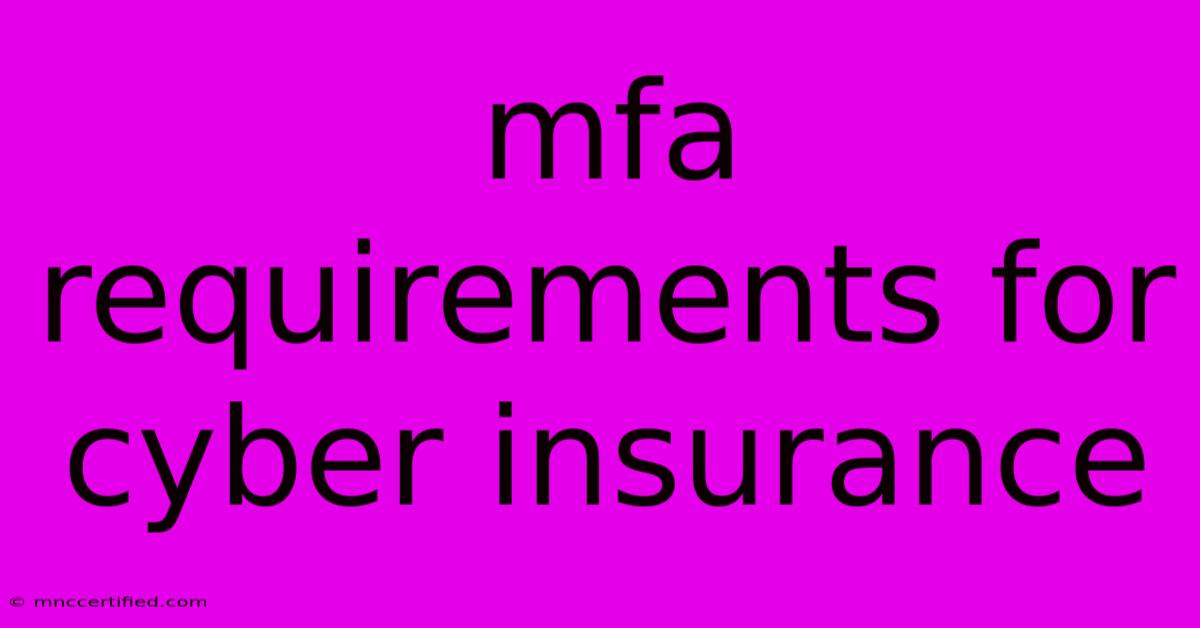Mfa Requirements For Cyber Insurance

Table of Contents
Understanding MFA Requirements for Cyber Insurance: A Guide for Businesses
In today's digital world, cybersecurity is paramount, and cyber insurance has become a crucial component of risk management for businesses of all sizes. But, are you aware that your cyber insurance policy may have specific requirements regarding multi-factor authentication (MFA)? This article explores the significance of MFA in the context of cyber insurance, breaking down the requirements, benefits, and how to implement it effectively.
The Growing Importance of MFA
Multi-factor authentication (MFA) is a security measure that requires users to provide multiple forms of identification before granting access to sensitive systems or data. It adds an extra layer of protection, significantly reducing the risk of unauthorized access even if one authentication factor is compromised.
Why is MFA so vital?
- Enhanced Security: MFA makes it exponentially harder for attackers to gain access to your systems, even if they obtain passwords through phishing attacks or other means.
- Compliance with Regulations: Many regulatory bodies, including PCI DSS (Payment Card Industry Data Security Standard) and HIPAA (Health Insurance Portability and Accountability Act), mandate the use of MFA for sensitive data.
- Reduced Risk of Data Breaches: By implementing MFA, businesses can significantly reduce the likelihood of data breaches, which can lead to financial losses, reputational damage, and legal consequences.
MFA Requirements in Cyber Insurance Policies
Cyber insurance providers are increasingly incorporating MFA requirements into their policies. This is because implementing MFA demonstrates a commitment to cybersecurity and reduces the insurer's risk. Here's why:
- Lowered Risk of Claims: MFA significantly reduces the likelihood of cyberattacks and data breaches, leading to fewer claims against the insurance policy.
- Reduced Premiums: Businesses with robust security measures, including MFA, can often negotiate lower premiums as they are considered lower-risk clients.
- Improved Coverage: Some insurance providers offer enhanced coverage or benefits to businesses that meet specific security criteria, including MFA implementation.
Common MFA Requirements in Cyber Insurance
While MFA requirements may vary depending on the insurer and the specific policy, here are some common elements:
- Types of MFA: Policies may specify the acceptable MFA methods, such as SMS codes, email verification, push notifications, hardware tokens, or biometrics.
- Scope of Implementation: Some policies may require MFA across all systems and user accounts, while others may focus on critical applications or data.
- Compliance Monitoring: Insurers may require regular audits or assessments to ensure ongoing compliance with MFA requirements.
Implementing MFA Effectively
Implementing MFA effectively is crucial to achieving its full benefits. Consider the following best practices:
- Choose the Right MFA Methods: Select MFA methods that are user-friendly, secure, and suitable for your specific needs.
- Implement MFA Across All Critical Systems: Apply MFA to all systems and applications that handle sensitive data or have access to critical infrastructure.
- Train Employees on MFA Usage: Ensure that all employees understand the importance of MFA and are trained on how to use it correctly.
- Regularly Review and Update MFA Policies: Regularly review your MFA policies and practices to ensure they remain effective and compliant with industry best practices.
Conclusion
MFA is no longer a luxury but a crucial element of responsible cybersecurity. By understanding the MFA requirements in your cyber insurance policy and implementing it effectively, you can significantly enhance your business's security posture, reduce your risk of cyberattacks, and potentially lower your insurance premiums. This proactive approach demonstrates a commitment to cybersecurity and strengthens your overall risk management strategy. Remember, proactive security measures, like implementing MFA, not only benefit your business but also improve your standing with cyber insurance providers, leading to better coverage and protection.

Thank you for visiting our website wich cover about Mfa Requirements For Cyber Insurance. We hope the information provided has been useful to you. Feel free to contact us if you have any questions or need further assistance. See you next time and dont miss to bookmark.
Featured Posts
-
Gauchos Face Stanford In Ncaa Tournament Opener
Nov 12, 2024
-
School Donates To Paddy Mc Guinness Cycle
Nov 12, 2024
-
Ault Alliance Stock Prediction 2024
Nov 12, 2024
-
Dogecoin Futures Open Interest Reaches All Time High
Nov 12, 2024
-
Immigration Under Tom Homan Whats Next
Nov 12, 2024